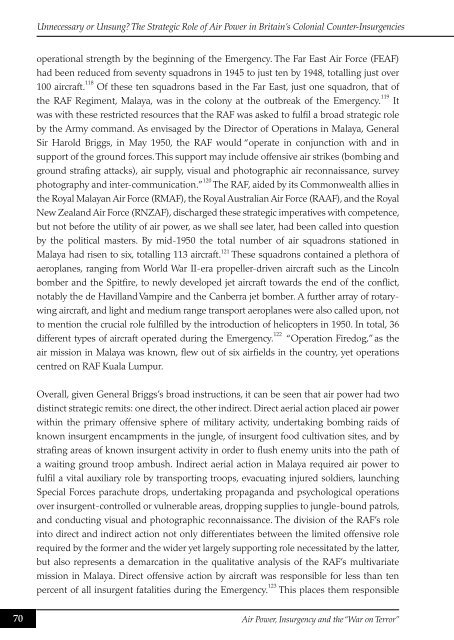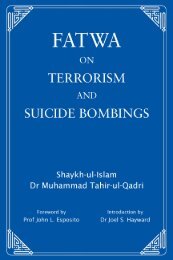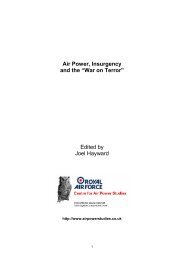Air Power, Insurgency and the âWar on Terrorâ - Prof. Joel Hayward's ...
Air Power, Insurgency and the âWar on Terrorâ - Prof. Joel Hayward's ...
Air Power, Insurgency and the âWar on Terrorâ - Prof. Joel Hayward's ...
Create successful ePaper yourself
Turn your PDF publications into a flip-book with our unique Google optimized e-Paper software.
Unnecessary or Unsung? The Strategic Role of <str<strong>on</strong>g>Air</str<strong>on</strong>g> <str<strong>on</strong>g>Power</str<strong>on</strong>g> in Britain’s Col<strong>on</strong>ial Counter-Insurgencies<br />
operati<strong>on</strong>al strength by <str<strong>on</strong>g>the</str<strong>on</strong>g> beginning of <str<strong>on</strong>g>the</str<strong>on</strong>g> Emergency. The Far East <str<strong>on</strong>g>Air</str<strong>on</strong>g> Force (FEAF)<br />
had been reduced from seventy squadr<strong>on</strong>s in 1945 to just ten by 1948, totalling just over<br />
100 aircraft. 118 Of <str<strong>on</strong>g>the</str<strong>on</strong>g>se ten squadr<strong>on</strong>s based in <str<strong>on</strong>g>the</str<strong>on</strong>g> Far East, just <strong>on</strong>e squadr<strong>on</strong>, that of<br />
<str<strong>on</strong>g>the</str<strong>on</strong>g> RAF Regiment, Malaya, was in <str<strong>on</strong>g>the</str<strong>on</strong>g> col<strong>on</strong>y at <str<strong>on</strong>g>the</str<strong>on</strong>g> outbreak of <str<strong>on</strong>g>the</str<strong>on</strong>g> Emergency. 119 It<br />
was with <str<strong>on</strong>g>the</str<strong>on</strong>g>se restricted resources that <str<strong>on</strong>g>the</str<strong>on</strong>g> RAF was asked to fulfil a broad strategic role<br />
by <str<strong>on</strong>g>the</str<strong>on</strong>g> Army comm<str<strong>on</strong>g>and</str<strong>on</strong>g>. As envisaged by <str<strong>on</strong>g>the</str<strong>on</strong>g> Director of Operati<strong>on</strong>s in Malaya, General<br />
Sir Harold Briggs, in May 1950, <str<strong>on</strong>g>the</str<strong>on</strong>g> RAF would “operate in c<strong>on</strong>juncti<strong>on</strong> with <str<strong>on</strong>g>and</str<strong>on</strong>g> in<br />
support of <str<strong>on</strong>g>the</str<strong>on</strong>g> ground forces. This support may include offensive air strikes (bombing <str<strong>on</strong>g>and</str<strong>on</strong>g><br />
ground strafing attacks), air supply, visual <str<strong>on</strong>g>and</str<strong>on</strong>g> photographic air rec<strong>on</strong>naissance, survey<br />
photography <str<strong>on</strong>g>and</str<strong>on</strong>g> inter-communicati<strong>on</strong>.” 120 The RAF, aided by its Comm<strong>on</strong>wealth allies in<br />
<str<strong>on</strong>g>the</str<strong>on</strong>g> Royal Malayan <str<strong>on</strong>g>Air</str<strong>on</strong>g> Force (RMAF), <str<strong>on</strong>g>the</str<strong>on</strong>g> Royal Australian <str<strong>on</strong>g>Air</str<strong>on</strong>g> Force (RAAF), <str<strong>on</strong>g>and</str<strong>on</strong>g> <str<strong>on</strong>g>the</str<strong>on</strong>g> Royal<br />
New Zeal<str<strong>on</strong>g>and</str<strong>on</strong>g> <str<strong>on</strong>g>Air</str<strong>on</strong>g> Force (RNZAF), discharged <str<strong>on</strong>g>the</str<strong>on</strong>g>se strategic imperatives with competence,<br />
but not before <str<strong>on</strong>g>the</str<strong>on</strong>g> utility of air power, as we shall see later, had been called into questi<strong>on</strong><br />
by <str<strong>on</strong>g>the</str<strong>on</strong>g> political masters. By mid-1950 <str<strong>on</strong>g>the</str<strong>on</strong>g> total number of air squadr<strong>on</strong>s stati<strong>on</strong>ed in<br />
Malaya had risen to six, totalling 113 aircraft. 121 These squadr<strong>on</strong>s c<strong>on</strong>tained a plethora of<br />
aeroplanes, ranging from World War II-era propeller-driven aircraft such as <str<strong>on</strong>g>the</str<strong>on</strong>g> Lincoln<br />
bomber <str<strong>on</strong>g>and</str<strong>on</strong>g> <str<strong>on</strong>g>the</str<strong>on</strong>g> Spitfire, to newly developed jet aircraft towards <str<strong>on</strong>g>the</str<strong>on</strong>g> end of <str<strong>on</strong>g>the</str<strong>on</strong>g> c<strong>on</strong>flict,<br />
notably <str<strong>on</strong>g>the</str<strong>on</strong>g> de Havill<str<strong>on</strong>g>and</str<strong>on</strong>g> Vampire <str<strong>on</strong>g>and</str<strong>on</strong>g> <str<strong>on</strong>g>the</str<strong>on</strong>g> Canberra jet bomber. A fur<str<strong>on</strong>g>the</str<strong>on</strong>g>r array of rotarywing<br />
aircraft, <str<strong>on</strong>g>and</str<strong>on</strong>g> light <str<strong>on</strong>g>and</str<strong>on</strong>g> medium range transport aeroplanes were also called up<strong>on</strong>, not<br />
to menti<strong>on</strong> <str<strong>on</strong>g>the</str<strong>on</strong>g> crucial role fulfilled by <str<strong>on</strong>g>the</str<strong>on</strong>g> introducti<strong>on</strong> of helicopters in 1950. In total, 36<br />
different types of aircraft operated during <str<strong>on</strong>g>the</str<strong>on</strong>g> Emergency. 122<br />
“Operati<strong>on</strong> Firedog,” as <str<strong>on</strong>g>the</str<strong>on</strong>g><br />
air missi<strong>on</strong> in Malaya was known, flew out of six airfields in <str<strong>on</strong>g>the</str<strong>on</strong>g> country, yet operati<strong>on</strong>s<br />
centred <strong>on</strong> RAF Kuala Lumpur.<br />
Overall, given General Briggs’s broad instructi<strong>on</strong>s, it can be seen that air power had two<br />
distinct strategic remits: <strong>on</strong>e direct, <str<strong>on</strong>g>the</str<strong>on</strong>g> o<str<strong>on</strong>g>the</str<strong>on</strong>g>r indirect. Direct aerial acti<strong>on</strong> placed air power<br />
within <str<strong>on</strong>g>the</str<strong>on</strong>g> primary offensive sphere of military activity, undertaking bombing raids of<br />
known insurgent encampments in <str<strong>on</strong>g>the</str<strong>on</strong>g> jungle, of insurgent food cultivati<strong>on</strong> sites, <str<strong>on</strong>g>and</str<strong>on</strong>g> by<br />
strafing areas of known insurgent activity in order to flush enemy units into <str<strong>on</strong>g>the</str<strong>on</strong>g> path of<br />
a waiting ground troop ambush. Indirect aerial acti<strong>on</strong> in Malaya required air power to<br />
fulfil a vital auxiliary role by transporting troops, evacuating injured soldiers, launching<br />
Special Forces parachute drops, undertaking propag<str<strong>on</strong>g>and</str<strong>on</strong>g>a <str<strong>on</strong>g>and</str<strong>on</strong>g> psychological operati<strong>on</strong>s<br />
over insurgent-c<strong>on</strong>trolled or vulnerable areas, dropping supplies to jungle-bound patrols,<br />
<str<strong>on</strong>g>and</str<strong>on</strong>g> c<strong>on</strong>ducting visual <str<strong>on</strong>g>and</str<strong>on</strong>g> photographic rec<strong>on</strong>naissance. The divisi<strong>on</strong> of <str<strong>on</strong>g>the</str<strong>on</strong>g> RAF’s role<br />
into direct <str<strong>on</strong>g>and</str<strong>on</strong>g> indirect acti<strong>on</strong> not <strong>on</strong>ly differentiates between <str<strong>on</strong>g>the</str<strong>on</strong>g> limited offensive role<br />
required by <str<strong>on</strong>g>the</str<strong>on</strong>g> former <str<strong>on</strong>g>and</str<strong>on</strong>g> <str<strong>on</strong>g>the</str<strong>on</strong>g> wider yet largely supporting role necessitated by <str<strong>on</strong>g>the</str<strong>on</strong>g> latter,<br />
but also represents a demarcati<strong>on</strong> in <str<strong>on</strong>g>the</str<strong>on</strong>g> qualitative analysis of <str<strong>on</strong>g>the</str<strong>on</strong>g> RAF’s multivariate<br />
missi<strong>on</strong> in Malaya. Direct offensive acti<strong>on</strong> by aircraft was resp<strong>on</strong>sible for less than ten<br />
percent of all insurgent fatalities during <str<strong>on</strong>g>the</str<strong>on</strong>g> Emergency. 123 This places <str<strong>on</strong>g>the</str<strong>on</strong>g>m resp<strong>on</strong>sible<br />
70<br />
<str<strong>on</strong>g>Air</str<strong>on</strong>g> <str<strong>on</strong>g>Power</str<strong>on</strong>g>, <str<strong>on</strong>g>Insurgency</str<strong>on</strong>g> <str<strong>on</strong>g>and</str<strong>on</strong>g> <str<strong>on</strong>g>the</str<strong>on</strong>g> “War <strong>on</strong> Terror”





